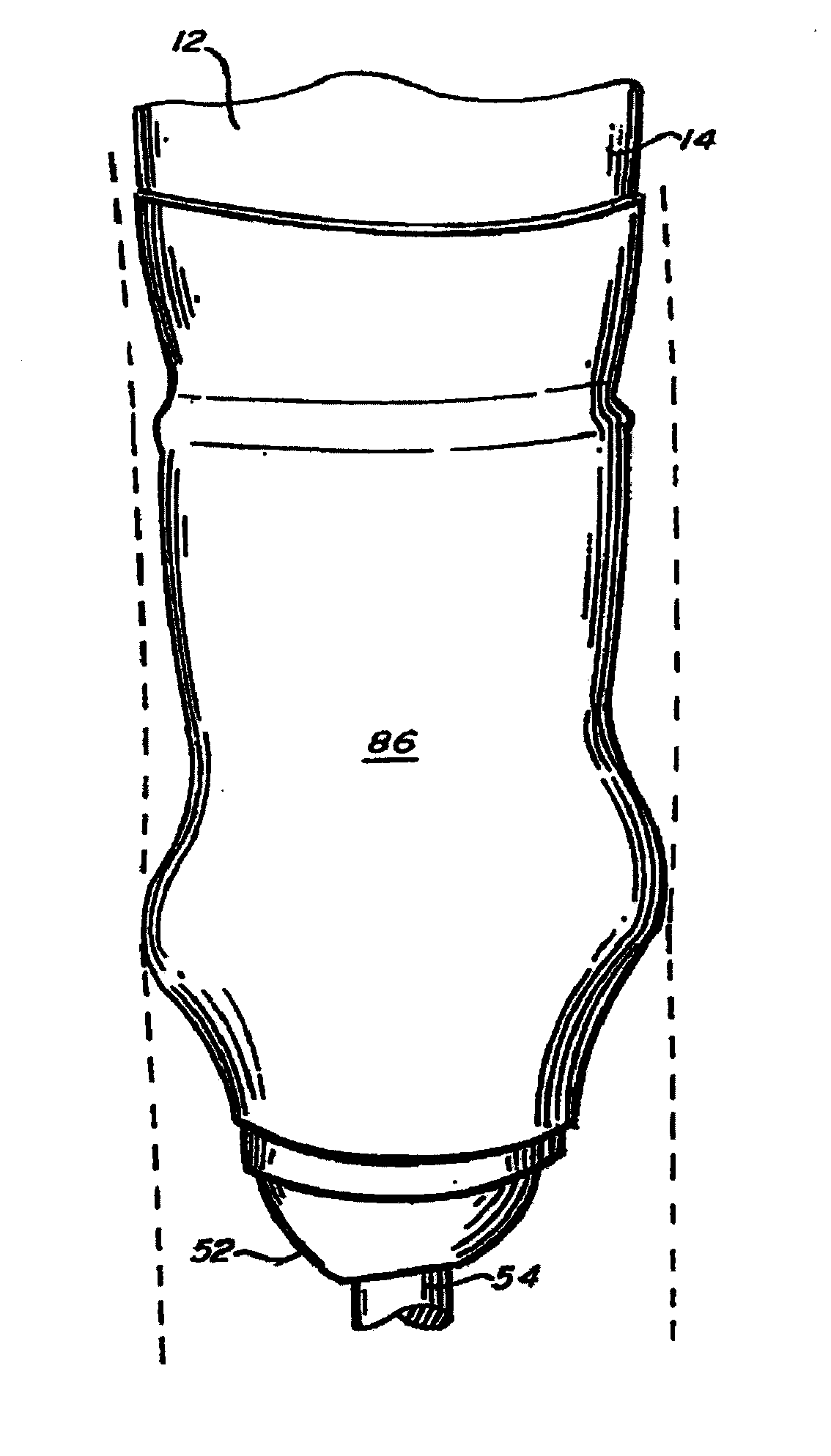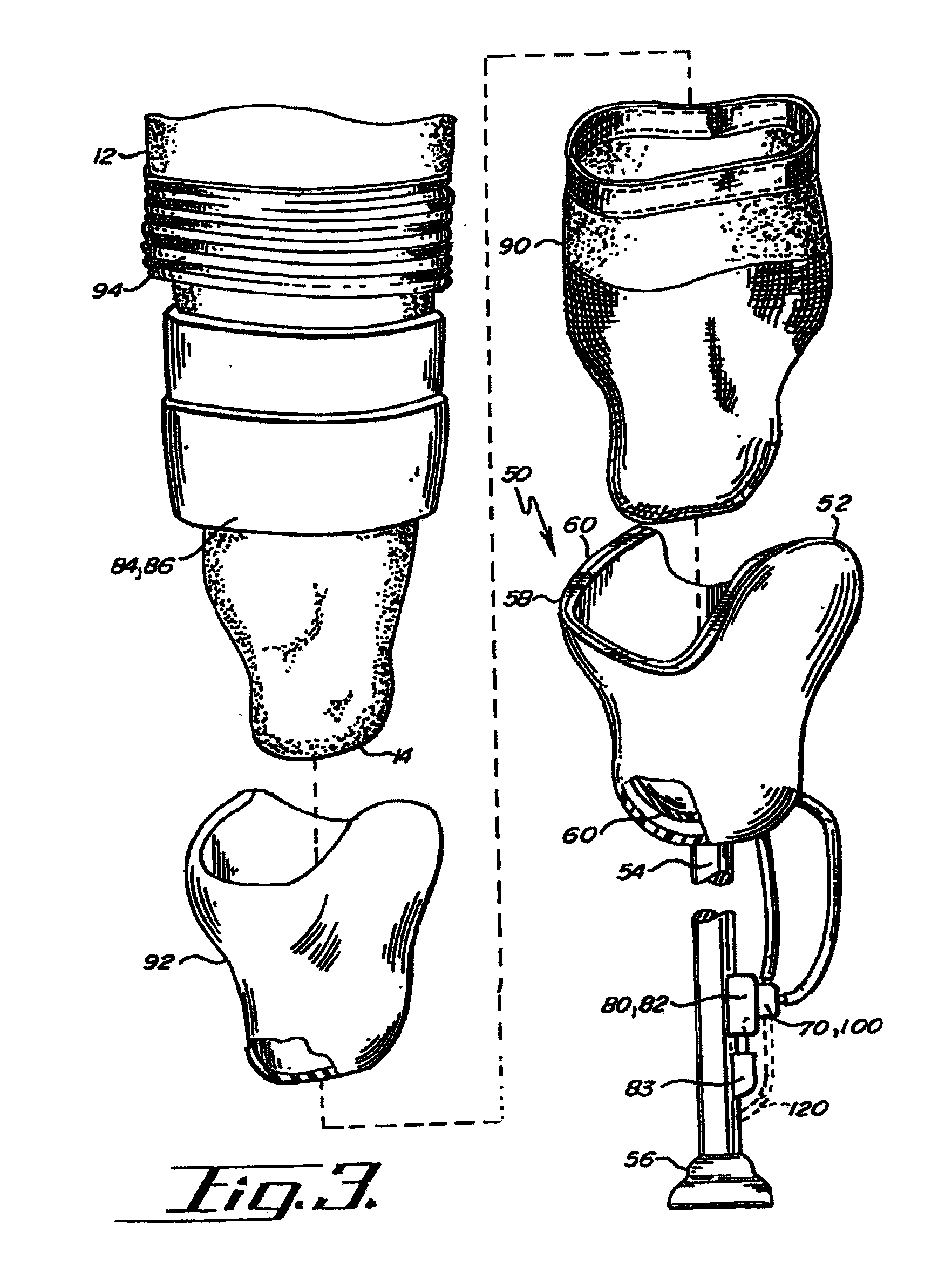Socket liner for artificial limb
a technology of artificial limbs and socks, applied in the field of prosthetic devices, can solve the problems of large shear force on the stump, large amount of nerve bundle pressure or restriction, dramatic atrophy and tissue loss, etc., and achieve the effect of reducing air leakag
- Summary
- Abstract
- Description
- Claims
- Application Information
AI Technical Summary
Benefits of technology
Problems solved by technology
Method used
Image
Examples
first embodiment
[0051]the hypobarically-controlled artificial limb 50 is shown in FIG. 4. The hypobarically-controlled artificial limb 50 further includes a flexible inner socket 60 with a cavity 62 with a volume and shape for receiving a substantial portion of the residual limb 14 and fitting in the space 58 between the outer socket 52 and the residual limb 14. The inner socket 60 has an inner surface 64 opposing the residual limb 14 and an outer surface 66 opposing the outer socket 52.
[0052]A vacuum source 70 may conveniently be attached to the shin or pylori 54. The vacuum source 70 may preferably be a mechanical or motor-driven pump 72. The vacuum source 70 is connected to a power source 83, which may be a battery.
[0053]A vacuum valve 74 is suitably connected to the vacuum source 70. The vacuum valve 74 may preferably be disposed on the outer socket 52. A vacuum tube 76 connects the vacuum valve 74 to the cavity 62. It will be seen that the vacuum source will cause the residual limb 14 to be dr...
third embodiment
[0071]The vacuum source 70, under control of the regulator means 80, will compensate for reduced residual limb volume up to a certain point. From that point on, the regulator means 80 will cause the positive air pressure source 100 to further compensate for reduced residual limb volume as described above. The third embodiment thus uses both vacuum and positive air pressure working together to lock the residual limb 14 into the inner socket 60 and reduce socket volume to compensate for fluid loss in the residual limb 14. The exact point at which the changeover is made between vacuum compensation and positive air pressure compensation is controlled by the regulator means 80, which as described may be a digital computer appropriately programmed for the socket environment.
[0072]A fourth embodiment of the hypobarically-controlled artificial limb 50 is shown in FIG. 8. The fourth embodiment is like the first embodiment, but includes two vacuum valves: a first vacuum valve 106 and a second...
fourth embodiment
[0076]The fourth embodiment may also include a positive air pressure source 100 as previously described, to adjust the size of the inner socket 60B to compensate for decreased residual limb volume.
[0077]The fourth embodiment may also include a thin sheath 90, liner 92, and second sleeve 94, as previously described (see FIG. 3).
[0078]The positive air pressure source 100 may also be used for shock absorption and a dynamic response in the ankle and foot sections of the artificial limb 50, by means of a connection 120.
[0079]A fifth embodiment of the hypobarically-controlled artificial limb 50 is shown in FIG. 10. This embodiment is the same as the first embodiment shown in FIG. 4, with some changes. First, vacuum source 71 may be a hand-operated vacuum pump 71 which may remove air from the cavity 62 down to approximately 15-25 inches of mercury. A suitable hand-operated vacuum pump is marketed under the trademark MITY VAC II® by Neward Enterprises, Inc. of Cucamonga, Calif.
PUM
 Login to View More
Login to View More Abstract
Description
Claims
Application Information
 Login to View More
Login to View More - R&D
- Intellectual Property
- Life Sciences
- Materials
- Tech Scout
- Unparalleled Data Quality
- Higher Quality Content
- 60% Fewer Hallucinations
Browse by: Latest US Patents, China's latest patents, Technical Efficacy Thesaurus, Application Domain, Technology Topic, Popular Technical Reports.
© 2025 PatSnap. All rights reserved.Legal|Privacy policy|Modern Slavery Act Transparency Statement|Sitemap|About US| Contact US: help@patsnap.com



